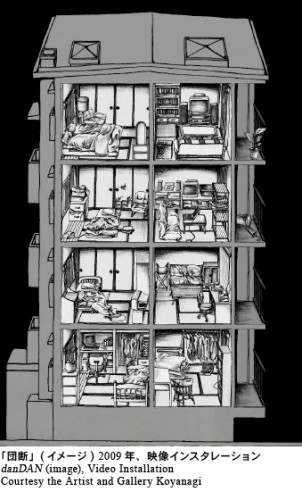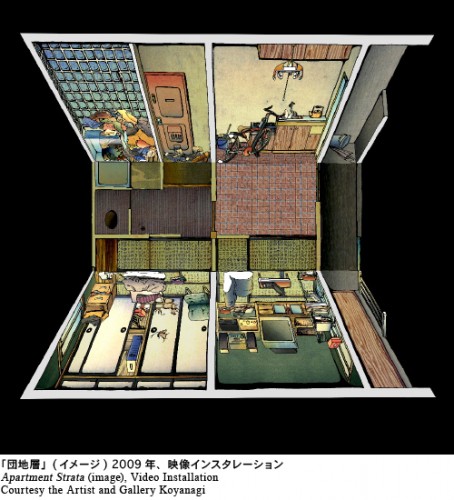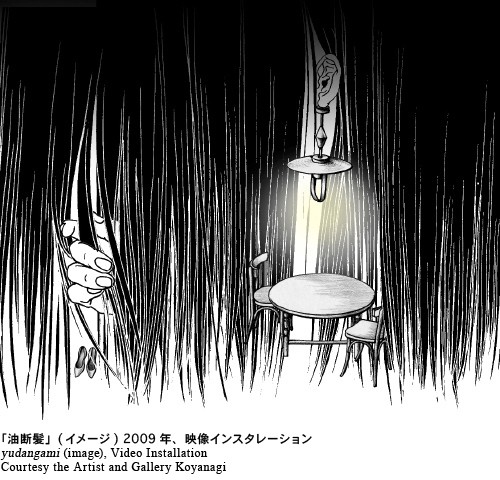Originality manifested in what we choose

An artist who presents scenes from contemporary living, images emblematic of Japan, and in recent years, her own inner life, via video installations featuring hand-drawn pictures and colors and lines reminiscent of ukiyo-e prints, is now marking a decade since her debut. In this milestone year, her latest solo outing offers five new video installations, plus associated events including collaborations with dancers and theater companies. Here she discusses her personal view of the generations – as reflected in the title of this new exhibition – and how it influences her take on creative practice.
Interview: ART iT
 A ‘table of contents’ for Tabaimo: DANMEN. Furnishings of different individual tastes crammed into various apartments evoke the personality of each occupant; they also give entrée to the exhibited works. The characters in these adjoining spaces all bear a relationship to the image of the collective housing block as well as to all other exhibited works.
A ‘table of contents’ for Tabaimo: DANMEN. Furnishings of different individual tastes crammed into various apartments evoke the personality of each occupant; they also give entrée to the exhibited works. The characters in these adjoining spaces all bear a relationship to the image of the collective housing block as well as to all other exhibited works.*The artist’s commentary from Tabaimo: Danmen
– First up, tell us about the title for this latest show. Why the Danmen, (cross-section) generation?
I took it from the phrase ‘dankai generation’ referring to the post-war baby boomers. I have quite a lot to do with people of this age group, and was pondering the contrasts, and commonalities, between their generation and our own. One of these individuals happens to be Kato Yoshihiro of the Zero jigen avant-garde art collective. In many ways you could say their position is opposite to our own, but I sensed certain underlying traits common to us both, and felt we were working toward the same objectives.
– The expression dankai generation calls to mind people born in the late 1940s, whose youth coincided with Japan’s era of high economic growth, and who experienced the student movements of the late 1960s. Are social and political associations of this sort connected with your focus this time?
For this show I’ve steered clear of the sociological aspects. The generation of us born in the late 1970s tend to believe the ‘individual’ is capable of anything. However while PCs and many other new tools have been developed that increase the tasks able to be performed by individuals, on the other hand it means we’re now obliged to do everything by ourselves. In contrast, the dankai generation is characterized, certainly as I see it, by an emphasis on the group. Unlike nowadays, a lot of what they did would not have been feasible without some division of duties. This applied also when it came to making things; I suspect professionals in various fields got together and worked as a team. Think of it like a sushi roll: each of the filling ingredients an artisan, plus someone who acted as the ‘nori’ holding it all together. The result was a single form. Whereas we are each a single piece of a roll, namely, one of the ‘danmen’ (cross-section) generation. The result when one individual does everything is different to that when something is produced by a group, and while at a glance may look the same in cross-section, in actual fact it will possess myriad idiosyncrasies. Apartment Strata (2009) symbolizes that idea – the theme of this show – perfectly.
Finding the identity of a generation in cross-sections of the everyday
I first started to think about this sort of thing when taking part in the GOTH: Reality of the Departed World show staged at the Yokohama Museum of Art in 2008. For example, people who dress in ‘Goth-Loli’ fashions may all look the same in the eyes of others, but each actually thinks carefully about how to express her own personal identity. Some pointed out that the ‘life and death’ theme of that show was not especially new, but I think each era has a different approach to such universal themes that’s deserving of consideration.
– Would it also be fair to say that compared to before, artists have more options for expressing themselves?
Earlier generations of artists possessed the powers to produce things from scratch, but these days it’s difficult to create anything totally new from the ground up. Each task constitutes a ‘collage’, each part is something already existing, but I’ve no problem with that. I believe there is still potential to display originality in aspects such as how work is received, and methods of output, so I prefer to channel my own powers into the production process. I believe originality is manifested in what we choose.
 The estate comprises several buildings, each with multiple dwelling units whose occupants might coexist totally oblivious to their immediate neighbors – such is life in contemporary society. Although dwelling within a collective body, they hold themselves in higher regard and act unconcerned as an expression of self-worth. Despite actually living within arm’s reach of one another, they content themselves with merely gathering information and virtual contact.
The estate comprises several buildings, each with multiple dwelling units whose occupants might coexist totally oblivious to their immediate neighbors – such is life in contemporary society. Although dwelling within a collective body, they hold themselves in higher regard and act unconcerned as an expression of self-worth. Despite actually living within arm’s reach of one another, they content themselves with merely gathering information and virtual contact.*The artist’s commentary from Tabaimo: Danmen
Fellow members of the ‘danmen generation’ tackle collaborations between different genres
– Another standout feature this time are your collaborations over the period of the exhibition with artists from the theatrical, dance and music worlds.
total eclipse (first performed 2007) by Kyoto theater company WANDERING PARTY, of which my childhood friend Yamamoto Maki is a member, was an important inspiration while I was thinking up a concept for the exhibition, and I’ve commissioned them for a repeat performance. I plan to use a new video for the lead-in.
I first encountered the dancer Yasumoto Masako when I went to see a work by the Israeli Batsheva Dance Company. I then saw her in action herself, and approached her proposing we do a live dance performance together. My idea was to do something unlike any of her previous dance expression, perhaps a little out of her comfort zone.
– What does yudangami, the title of the dance show, refer to?
‘Yudangami’ (lit. ‘unguarded hair’) is a word I made up, the image in my mind being that of a woman of dubious morals. She’s a character in the novel Akunin (author Yoshida Shuichi, serialized in the Asahi Shimbun 2006-07), for which I provided the illustrations. Motif for the work is Kaneko Miho, a woman who never quite commits to anything. I started by getting Tucker-san, the electronic organ artist who provided sound for my work Haunted House (2003), to create a soundtrack, then reworked for live performance a video I’d originally made as an installation. I’m hoping to project onto the stage a different video again, like lighting focused on the dancers.
The things I want to express have invariably been informed by outside offers, so I’m interested in people I’ve been fortunate to connect with. Plus, now marking ten years as an artist, I’m keen to work with people in other genres; in the hope that one product of that collaboration will be art of a new sort for me.
 A rendering of Miho Kaneko from Akunin, a relatively minor character in the novel. She seems like a good many women I’ve met or like myself and my own encounters with others. This video installation depicts unseen facets of her life story as I imagined them from those slices of the narrative where she plays a part. I sought to express them as repeated degrees of separation.
A rendering of Miho Kaneko from Akunin, a relatively minor character in the novel. She seems like a good many women I’ve met or like myself and my own encounters with others. This video installation depicts unseen facets of her life story as I imagined them from those slices of the narrative where she plays a part. I sought to express them as repeated degrees of separation.*The artist’s commentary from Tabaimo: Danmen
Tabaimo
Born 1975 in Hyogo Prefecture; lives in Nagano. Graduated Kyoto University of Art and Design in 1999, receiving the 1999 Kirin Contemporary Award grand prize for her graduation piece Japanese Kitchen. International exhibitions include the 2001 Yokohama Triennial, 2002 São Paulo Biennale, 2006 Biennale of Sydney, and 2007 Venice Biennale. Recent solo shows include YOROYORON Tabaimo (2006, Hara Museum of Contemporary Art) and Tabaimo (2006-07, Fondation Cartier pour l’art contemporain).
Tabaimo: danmen
2009.12.11 – 2010.3.3
Yokohama Museum of Art
http://www.yaf.or.jp/yma
